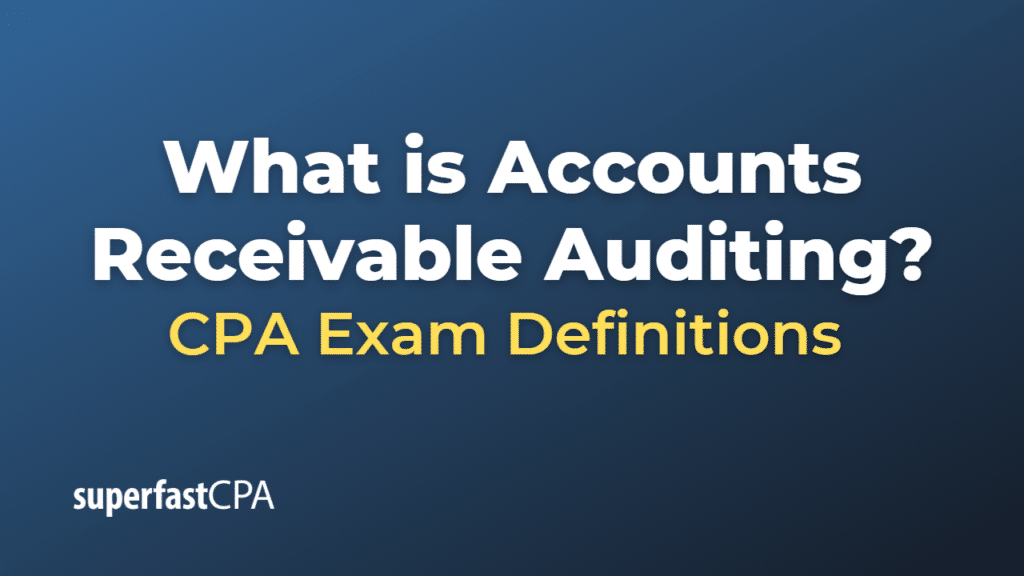Accounts Receivable Auditing
Accounts receivable auditing is a process where an auditor or an audit team reviews a company’s accounts receivable records, policies, and procedures to ensure their accuracy, completeness, and compliance with accounting standards and regulations. The primary objective of accounts receivable auditing is to identify and mitigate the risks of errors, misstatements, or fraud in the accounts receivable balance reported in the company’s financial statements.
Some key aspects of accounts receivable auditing include:
- Assessing internal controls: The auditor evaluates the effectiveness of the company’s internal controls related to accounts receivable, such as authorization of credit, approval of sales transactions, recording and reporting of receivables, and collection procedures. This helps the auditor identify any weaknesses or areas of concern that could lead to errors or misstatements.
- Confirming account balances: The auditor verifies the accuracy of the accounts receivable balances by confirming the amounts directly with customers. This is often done through a process called “accounts receivable confirmations,” where the auditor sends a letter or email to the customer requesting confirmation of the outstanding balance.
- Testing the accuracy of aging reports: The auditor reviews the company’s accounts receivable aging report to ensure that receivables are correctly classified based on the length of time they have been outstanding. This helps the auditor assess the adequacy of the allowance for doubtful accounts and evaluate the risk of uncollectible accounts.
- Analyzing accounts receivable turnover and days sales outstanding (DSO): The auditor reviews these key metrics to assess the efficiency of the company’s credit and collection policies and identify any potential issues that could impact cash flow.
- Assessing the adequacy of the allowance for doubtful accounts: The auditor evaluates the company’s estimates for bad debts and tests the reasonableness of the allowance for doubtful accounts. This helps ensure that the company has made appropriate provisions for potential uncollectible accounts.
- Reviewing write-offs and recoveries: The auditor examines the company’s procedures for writing off uncollectible accounts and recovering previously written-off accounts to ensure they are in compliance with accounting standards and company policies.
- Evaluating compliance with accounting standards and regulations: The auditor ensures that the company’s accounts receivable policies and procedures are in compliance with applicable accounting standards (such as GAAP or IFRS) and any relevant regulatory requirements.
By conducting an accounts receivable audit, auditors provide assurance to the company’s management, shareholders, and other stakeholders that the reported accounts receivable balance is accurate, reliable, and free from material misstatements or fraud. This helps build trust in the company’s financial reporting and contributes to maintaining the company’s overall financial health.
Example of Accounts Receivable Auditing
Let’s consider a fictional company called “TechMaster,” which sells computer hardware and software products on credit to various clients. TechMaster’s management has engaged an audit firm to perform an accounts receivable audit to ensure the accuracy and reliability of their financial statements.
Here’s a simplified example of the steps the audit firm might take during the accounts receivable audit:
- Assessing internal controls:
- Review TechMaster’s credit approval process, sales transaction authorization, and recording and reporting of receivables.
- Evaluate the company’s collection procedures and policies.
- Confirming account balances:
- Select a sample of clients from TechMaster’s accounts receivable listing and send confirmation letters or emails requesting confirmation of outstanding balances.
- Testing the accuracy of aging reports:
- Review the company’s accounts receivable aging report and verify that receivables are classified correctly based on the age of the outstanding amounts.
- Analyzing accounts receivable turnover and days sales outstanding (DSO):
- Calculate the accounts receivable turnover ratio and DSO for TechMaster to evaluate the efficiency of their credit and collection policies.
- Assessing the adequacy of the allowance for doubtful accounts:
- Review TechMaster’s methodology for estimating bad debts and evaluate the reasonableness of the allowance for doubtful accounts.
- Reviewing write-offs and recoveries:
- Examine the company’s procedures for writing off uncollectible accounts and recovering previously written-off accounts.
- Evaluating compliance with accounting standards and regulations:
- Ensure that TechMaster’s accounts receivable policies and procedures are in compliance with applicable accounting standards (such as GAAP or IFRS) and any relevant regulatory requirements.
Upon completing the audit, the audit firm would report its findings to TechMaster’s management and provide recommendations for any improvements or adjustments needed to ensure accurate and reliable accounts receivable reporting. This audit process helps build trust in the company’s financial reporting and contributes to maintaining TechMaster’s overall financial health.












